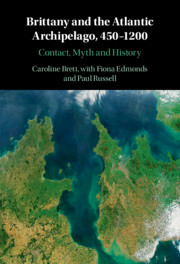Book contents
- Brittany and the Atlantic Archipelago, 450–1200
- Brittany and the Atlantic Archipelago, 450–1200
- Copyright page
- Contents
- Maps
- Tables
- Preface and Acknowledgements
- Abbreviations
- Additional material
- Introduction
- 1 Archaeology and the Origins of Brittany
- 2 Settlement and Isolation, 450–800
- 3 Brittany and Its Insular Past in the Ninth Century
- 4 Insular Contact and the Manuscript-Culture of Brittany in the Ninth and Tenth Centuries
- 5 From Invasion to Conquest: Brittany and Its History, 919–1066
- 6 Saints and Seaways: The Cult of Saints in Brittany and Its Archipelagic Links
- 7 Bretons and Britons in the Norman and Angevin Empires, 1066–1203
- Conclusion
- Bibliography
- Index
4 - Insular Contact and the Manuscript-Culture of Brittany in the Ninth and Tenth Centuries
Published online by Cambridge University Press: 21 October 2021
- Brittany and the Atlantic Archipelago, 450–1200
- Brittany and the Atlantic Archipelago, 450–1200
- Copyright page
- Contents
- Maps
- Tables
- Preface and Acknowledgements
- Abbreviations
- Additional material
- Introduction
- 1 Archaeology and the Origins of Brittany
- 2 Settlement and Isolation, 450–800
- 3 Brittany and Its Insular Past in the Ninth Century
- 4 Insular Contact and the Manuscript-Culture of Brittany in the Ninth and Tenth Centuries
- 5 From Invasion to Conquest: Brittany and Its History, 919–1066
- 6 Saints and Seaways: The Cult of Saints in Brittany and Its Archipelagic Links
- 7 Bretons and Britons in the Norman and Angevin Empires, 1066–1203
- Conclusion
- Bibliography
- Index
Summary
Between a hundred and two hundred manuscripts connected with Brittany, written in the ninth and tenth centuries, can be identified by their script, contents and Old Breton glosses; they survived the Viking age by being taken to Francia or England, and open a window on the sources and external contacts of Bretons’ scholarly culture. The manuscripts contain a wide variety of Latin texts, biblical, legal, grammatical, technical and historical. One of the most important subsets consists of manuscripts of the Irish canon law compilation, Collectio Canonum Hibernensis: it is unclear whether the text was obtained from Ireland or via Irish-influenced centres on the Continent, but the ability of Breton scribes to access both the extant versions in full, together with some of their source-texts, implies contact with the milieu of the original compilers. Glosses show that even texts that were widely available on the Continent, like grammars and the scientific writings of Bede, reached Bretons through Irish contacts. Some manuscripts reveal collaboration between annotators writing in Irish, Welsh and Breton, providing a context for the sharing of hagiographical information discussed in the previous chapter. The occasional sharing of rare texts allows us to pinpoint a few centres where such encounters may have taken place, among them are Reichenau and Echternach. The survival of Breton manuscripts in England suggests that Breton scholarship played a considerable part in the reconstruction of the English Church in the tenth century, after the Viking age.
- Type
- Chapter
- Information
- Brittany and the Atlantic Archipelago, 450–1200 , pp. 143 - 179Publisher: Cambridge University PressPrint publication year: 2021

